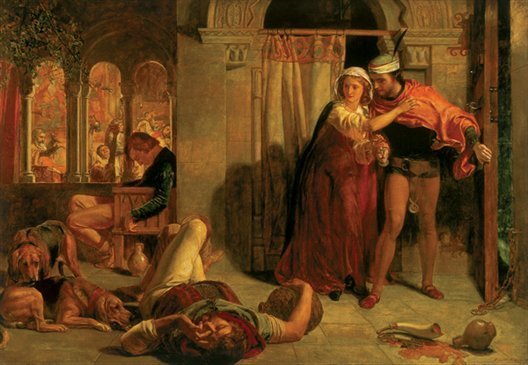
William Holman Hunt,
The Eve of St. Agnes, 1848.
Oil on canvas, 77.4 x 113 cm.
Guildhall Art Gallery,
Corporation of London, London.
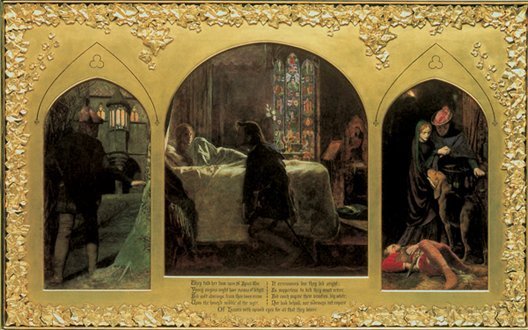
Arthur Hughes,
The Eve of St. Agnes, 1856.
Oil on canvas, 71 x 124.5 cm.
Tate Gallery, London.
The argument “Burne-Jones is original; I resemble Burne-Jones, therefore I am original,” may be worth something as a syllogism, but that does not make it any less absurd. Ruskin wrote “The only doctrine or system that I consider my own is the rejection of that which is dogmatic rather than experimental, and that which is systematic instead of being useful: thus, my true followers will never be ‘Ruskinian.’ They will not follow my directions, but the feelings in their own souls and the will of their Creator.” And all the Pre-Raphaelites thought in the same way. Consequently, to imitate them is not to understand them; to borrow their formulae is to violate their creed; to follow them is to abandon them.
So another kind of imitation is possible. It consists of drawing inspiration from the ideas that made Watts and Burne-Jones original, a return to the source from which they emerged; but this is also dangerous. For the skilfulness and awkwardness, the tenderness and strength, even the spice and attractiveness of these masters should not make us forget that this source is artificial, and that artifice is not art. The somewhat paradoxical pleasure that we find in their deviations from nature, their refinements of grace, their exaggerations of emotion, their stylistic neologisms, their subtle grimaces, and their mysterious gestures, in all of these efforts to act on the mind rather than the eye, should not lead us out of the broad daylight of complete, honest beauty. For this pleasure is in reality more intellectual than aesthetic; it is that which we feel from Browning and Swinburne, not from van Dyck or Velázquez. It flatters the conceit of the thinker more than it excites the feelings of the artist. It is mixed with selfish motives, psychological curiosity and intellectual complacency. One can taste it for a moment, like a nameless and undated liqueur that is a combination of several different batches, which amuses the palate by intriguing it. But one should not make this one’s habitual drink, and certainly not peddle the recipe and recommend its manufacture. For if it is unimportant which bottle one chooses, as long as it is intoxicating, it is nonetheless important not to mix all the bottles together, because by playing this game one does not become drunk, but a drunkard, and one’s taste is forever dulled. The intellectual artist, the psychological artist, in a word the “intentionist” artist, torments himself for ten years over a great painting to express the ideas that his brother, the poet or novelist, could obtain in ten lines, and with livelier and more profound results. And during this time the painter forgets to provide us with sensations that a writer can never give. When Benozzo Gozzoli wanted to give a theological explanation of the Triumph of Saint Thomas Aquinas over the heresiarchs of his day, or when Perugino attempted to illustrate the ideas of Isabella of Mantua in The Battle of Love and Chastity (two paintings from the Primitive Gallery in the Louvre), they manage to give us a vague theology or a confused poem, but they do not match the marvels of the Uffizi or the Riccardi Palace. Forcing the plastic arts to express something of the human soul is quite simply uprooting them, accommodating them to other fields which are not noticeably enriched in the process. For when a painter tries to make a painting suggestive, the composition is overloaded, the limbs twist out of shape, and the details multiply in order to inform us of his thought or throw us into the domain of hypothesis. Forms are no longer chosen for their beauty or for their truth, but for what they signify or for their mystery. In a way, they are used merely as rebuses.
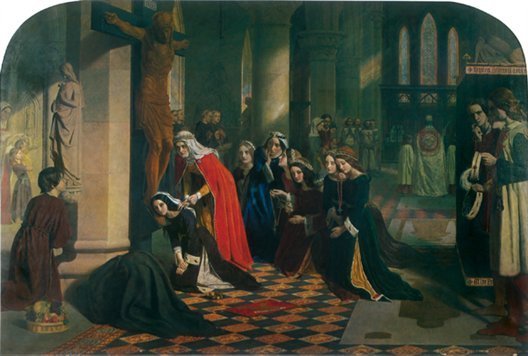
James Collinson, The Renunciation
of St. Elizabeth of Hungary, c. 1848-1850.
Oil on canvas, 120 x 182 cm.
Johannesburg Art Gallery, Johannesburg.
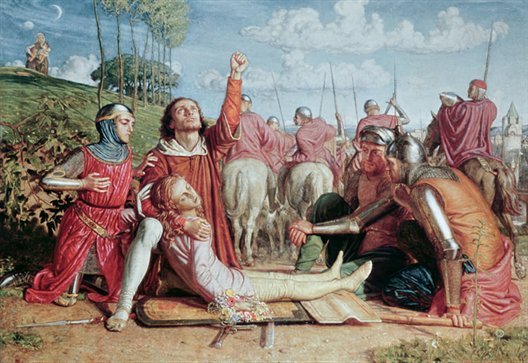
William Holman Hunt,
Rienzi Vowing to Obtain Justice for the
Death of his Young Brother, Slain in a Skirmish
between the Colonna and the Orsini Factions, 1849.
Private Collection.
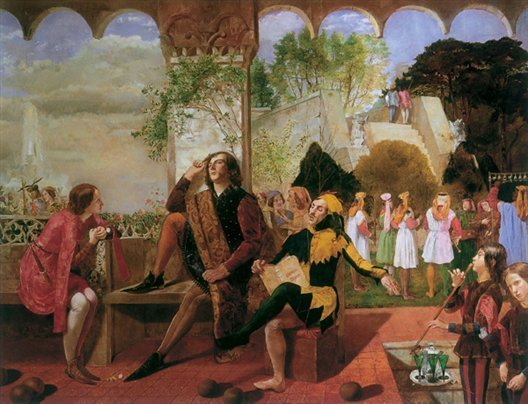
Walter Howell Deverell,
Twelfth Night, Act II, Scene III, 1850.
Oil on canvas, 101.6 x 132.1 cm.
Christie’s images, The FORBES
Magazine Collection, New York.
The anecdotal rebus of Hogarth and the psychological rebus of Burne-Jones; all English painting oscillates between these two terms, which seem to be two extremes and yet have something in common, if one considers how far they are from the normal point of view from which a subject is treated. And the pleasure that an aesthete feels when guessing the meaning of one of Burne-Jones’ rebuses quite resembles the pleasure that some bureaucrat might feel when deciphering those little symbolic tables found in the final pages of a newspaper. This pleasure is certainly legitimate, but it can hardly be called aesthetic, and cannot serve as a benchmark for evaluating works of art. Of all the errors that threaten contemporary art, of all the paradoxes of impressionism, naïve qualities of realism, and stereotypes of academic painting, among all this insipidity, coarseness, ignorance, and presumption, there is no theory worse than that of “intentionism” in art, because there is no other that so surely abolishes art itself. By following other paths, one goes astray in the aesthetic domain; by following this one, one leaves it entirely. Let us never abandon the beautiful French qualities of logic, order, harmony, simplicity, and moderation, which were Italian, which were Spanish, which were even Flemish, at the times when Italy, Spain, and Flanders were blessed by the hand of fortune which bestows artists on nations, or were the lands where the vagabond named Genius sought asylum. But if we must one day sacrifice these qualities, let it be to some great principle of art where aesthetic feelings elate us, where it is particularly the eyes that are conquered, where we find ourselves captivated by a philosophy that is a torment and not a thing of literature, that is a vanity but a thing of beauty, one of those that Keats tells us, in a famous verse, “is a joy for ever.” And let us be especially wary of theories that pretend to expand the role of art by making it into an intermediary for ideas or sentiments, for affirmations or doubts, theories that give the artist some other mission than to express beauty without sentences, without intentions, and without evangelism, as if there were something in the world which deserved to have beauty as its servant, interpreter, or herald! Let us be wary of those erroneous principles that claim to expand art by leading it astray, deepen it by destroying its foundations, or elevate it by subjugating it!